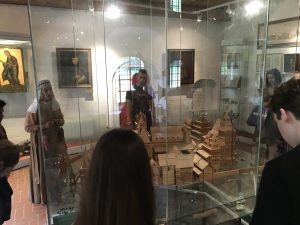Greetings from Moscow! We have had an extraordinary week in terms of language acquisition and cultural understanding. Students are beginning to put together the pieces of language they have acquired and are now able to communicate in complete sentences using complex constructions. I am astonished by the progress they have made over the course of just one month.
On Saturday, we enjoyed an excursion to Kolomenskoye, a former royal estate referred to as an eighth wonder of the world by visitors at the time. During their excursion, students viewed a model of how the palace looked before it was dismantled and saw an oak tree dating back to the time of Peter the Great. Their Russian tour guide discussed her traditional Russian clothing and offered students an insider’s view of Russian history.
You can see many photos from our excursions and outings on this blog, but since students spend much of their time in class, I thought you might be interested in seeing where the students take classes and what the university looks like. So here I present to you “A Day in the Life of an NSLI-Y student in Moscow.”

This is the main entrance to the school where our students take classes. The acronym for the university is RANEPA: The Russian Presidential Academy of National Economy and Public Administration. Their home page can be found here: http://www.ranepa.ru/eng/. RANEPA is the largest socioeconomic and humanities university in Europe, and it trains undergrads through post-docs.

The buildings don’t have names—only numbers. Here are signs indicating where to find the nine buildings that make up the campus.

Here is one of the groups of students with their teacher. Students study Russian four hours per day, Monday through Friday.

Here is the other group of students with their teacher. Notice the big bottle of water on the table to the right. Traditionally, Russians don’t drink a lot of water. More than any other beverage, they prefer tea. Since my students and I are accustomed to drinking water at home in the States, our program arranged to have water available in the classrooms for us. (As in much of Europe, drinking fountains in public buildings are highly uncommon in Russia.)
After classes we eat lunch together in one of the university cafeterias. The food—traditional Russian fare—is quite tasty.

Relaxing over lunch at the school cafeteria. Clockwise from left: Jacob, Anjali, Shea, Peter, Ottilie, Cheyenne, McLaren, and Grace.

Here is a typical cafeteria lunch: a couple of salads, a main dish, and a side.
A Russian lunch—the biggest meal of the day—consists of, at the very least, soup, a main course, a side dish, and bread. As Russians say, “Without bread, it’s not lunch.”
After lunch we have meetings, activities with peer language partners, or excursions. This week, we enjoyed two language enrichment activities led by the teachers.
Outside of class, students continue to explore the sights and sounds of Moscow. Here are some recent highlights. Tune in for more next week!

























